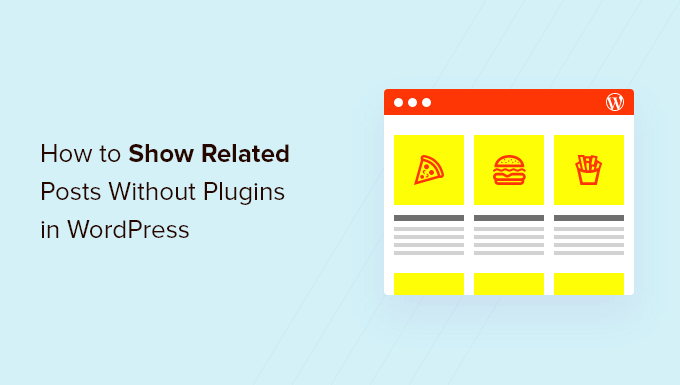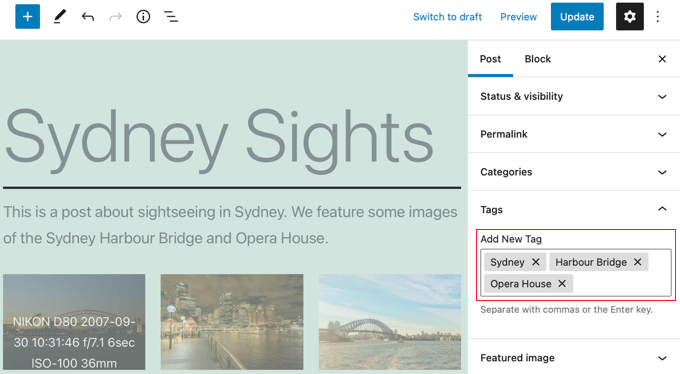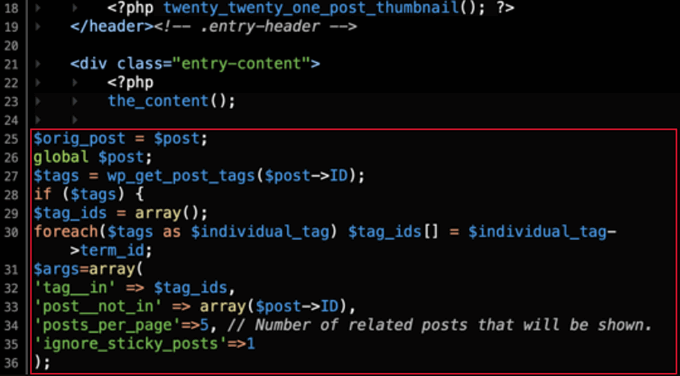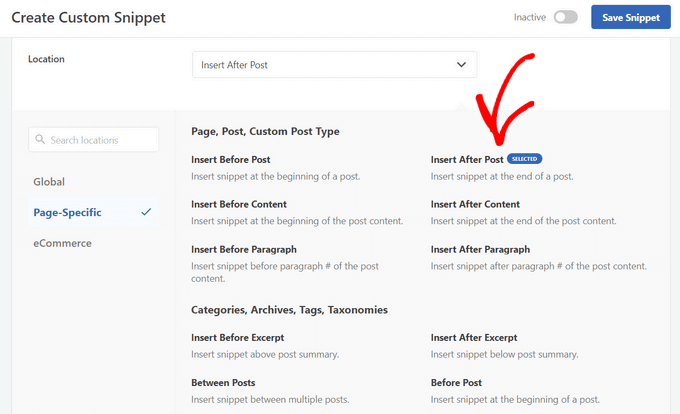¿Desea mostrar una lista de entradas relacionadas en su sitio web de WordPress y prefiere utilizar código en lugar de un plugin?
Cuando los visitantes de su blog hayan terminado de leer un artículo que les interese, ofrecerles una lista de entradas relacionadas les mantendrá interesados y les ayudará a encontrar nuevos contenidos que leer.
En este artículo, le mostraremos cómo mostrar entradas relacionadas con WordPress usando código, sin necesidad de plugins.

¿Por qué mostrar entradas relacionadas en WordPress?
Cuando tu blog de WordPress empieza a crecer, puede resultar más difícil para los usuarios encontrar otras entradas sobre el mismo debate.
Mostrar una lista de contenidos relacionados al final de cada entrada del blog es una buena forma de mantener a los visitantes en su sitio web y aumentar las visitas. También ayuda a mejorar la visibilidad de las páginas más importantes al mostrar los mejores contenidos donde la gente pueda encontrarlos fácilmente.
Si no está familiarizado con el código, entonces le resultará más sencillo elegir uno de los muchos plugins de WordPress para entradas relacionadas que pueden mostrar entradas relacionadas sin código.
Pero, si alguna vez te has preguntado si puedes mostrar entradas relacionadas sin usar un plugin, compartiremos dos algoritmos diferentes que puedes usar para generar entradas relacionadas con miniaturas usando sólo código:
Nota: Si desea mostrar una miniatura con cada entrada relacionada, asegúrese de añadir primero una imagen destacada a esas entradas.
Método 1: Cómo mostrar entradas relacionadas en WordPress por etiquetas
Una forma eficaz de localizar contenidos relacionados es buscar otras entradas que compartan las mismas etiquetas. Las etiquetas suelen utilizarse para centrarse en los detalles específicos que contiene una entrada.
Teniendo esto en cuenta, puede que desee seguir adelante y añadir algunas etiquetas comunes a las entradas que desea relacionar entre sí. Puede introducirlas en el cuadro “Etiquetas” del editor de WordPress.

Una vez que hayas añadido etiquetas a tus entradas, lo siguiente que debes hacer es añadir el siguiente fragmento de código a la plantilla single. php de tu tema.
Si necesitas ayuda para añadir código a tu sitio, consulta nuestra guía sobre cómo pegar fragmentos de código de la web en WordPress.
$orig_post = $post;
global $post;
$tags = wp_get_post_tags($post->ID);
if ($tags) {
$tag_ids = array();
foreach($tags as $individual_tag) $tag_ids[] = $individual_tag->term_id;
$args=array(
'tag__in' => $tag_ids,
'post__not_in' => array($post->ID),
'posts_per_page'=>5, // Number of related posts that will be shown.
'ignore_sticky_posts'=>1
);
$my_query = new wp_query( $args );
if( $my_query->have_posts() ) {
echo '<div id="relatedposts"><h3>Related Posts</h3><ul>';
while( $my_query->have_posts() ) {
$my_query->the_post(); ?>
<li><div class="relatedthumb"><a href="<?php the_permalink()?>" rel="bookmark" title="<?php the_title(); ?>"><!--?php the_post_thumbnail(); ?--></a></div>
<div class="relatedcontent">
<h3><a href="<?php the_permalink()?>" rel="bookmark" title="<?php the_title(); ?>"><!--?php the_title(); ?--></a></h3>
<!--?php the_time('M j, Y') ?-->
</div>
</li>
<!--?php }
echo '</ul--></ul></div>';
}
}
$post = $orig_post;
wp_reset_query();
Este código busca etiquetas asociadas a una página y ejecuta una consulta a la base de datos para obtener páginas con etiquetas similares.
¿Dónde debes colocar el código? Eso depende de tu tema, pero en la mayoría de los casos, deberías poder pegar el código en la plantilla single. php de tu tema después de la entrada principal y justo encima de la sección de comentarios.
Si utiliza el tema Twenty Twenty-One, como nosotros en nuestro sitio de demostración, un buen lugar para pegar el código es en el archivo template-parts/content/content-single. php después de la cabecera y justo después de <?php the_content();.

Esto mostrará automáticamente el contenido relacionado en cualquier entrada de WordPress. Tendrás que cambiar el estilo y la apariencia de tus entradas relacionadas para que coincidan con tu tema añadiendo CSS personalizado.

Consejo: En lugar de editar los archivos de su tema, lo que podría romper su sitio web, le recomendamos que utilice un plugin de fragmentos de código como WPCode.
WPCode hace que sea seguro y fácil añadir código personalizado en WordPress. Además, viene con opciones de ‘Inserción’ que le permiten insertar y ejecutar automáticamente fragmentos de código en lugares específicos de su sitio WordPress, como por ejemplo después de una entrada.

Para más detalles, consulte nuestra guía sobre cómo añadir código personalizado en WordPress. También puedes comprobar nuestra detallada reseña de WPCode para saber más acerca del plugin.
Método 2: Cómo mostrar entradas relacionadas en WordPress por categoría
Otra forma de mostrar contenido relacionado es listar entradas que estén en la misma categoría. La ventaja de este método es que la lista de entradas relacionadas casi nunca estará en blanco.
Como en el método 1, tienes que añadir un fragmento de código a la plantilla single. php de tu tema o en un plugin de fragmentos de código como WPCode. Para más detalles, consulta el Método 1 y nuestra guía sobre cómo añadir código personalizado en WordPress.
$orig_post = $post;
global $post;
$categories = get_the_category($post->ID);
if ($categories) {
$category_ids = array();
foreach($categories as $individual_category) $category_ids[] = $individual_category->term_id;
$args=array(
'category__in' => $category_ids,
'post__not_in' => array($post->ID),
'posts_per_page'=> 2, // Number of related posts that will be shown.
'ignore_sticky_posts'=>1
);
$my_query = new wp_query( $args );
if( $my_query->have_posts() ) {
echo '<div id="related_posts"><h3>Related Posts</h3><ul>';
while( $my_query->have_posts() ) {
$my_query->the_post();?>
<li><div class="relatedthumb"><a href="<?php the_permalink()?>" rel="bookmark" title="<?php the_title(); ?>"><!--?php the_post_thumbnail(); ?--></a></div>
<div class="relatedcontent">
<h3><a href="<?php the_permalink()?>" rel="bookmark" title="<?php the_title(); ?>"><!--?php the_title(); ?--></a></h3>
<!--?php the_time('M j, Y') ?-->
</div>
</li>
<!--?php }
echo '</ul--></ul></div>';
}
}
$post = $orig_post;
wp_reset_query();
Ahora verá una lista de contenidos relacionados en la parte inferior de cada entrada.
Si desea cambiar el estilo y la apariencia de sus páginas relacionadas, entonces tendrá que añadir CSS personalizado para que coincida con su tema.
Guías de expertos sobre entradas relacionadas en WordPress
¿Quieres saber más acerca de cómo mostrar entradas relacionadas en WordPress? Marca / comprueba estos útiles tutoriales sobre entradas relacionadas:
- Cómo mostrar entradas relacionadas en WordPress (paso a paso)
- Cómo mostrar entradas relacionadas del mismo autor en WordPress
- Cómo añadir entradas relacionadas integradas en entradas de blog de WordPress
- Cómo mostrar entradas aleatorias en WordPress
- Cómo mostrar páginas relacionadas en WordPress
Esperamos que este tutorial te haya ayudado a aprender cómo mostrar entradas relacionadas con miniaturas en WordPress sin plugins. Puede que también quieras aprender a hacer un seguimiento de los visitantes de tu sitio WordPress, o comprobar nuestra lista de 24 consejos para acelerar tu sitio web.
If you liked this article, then please subscribe to our YouTube Channel for WordPress video tutorials. You can also find us on Twitter and Facebook.




Syed Balkhi says
Hey WPBeginner readers,
Did you know you can win exciting prizes by commenting on WPBeginner?
Every month, our top blog commenters will win HUGE rewards, including premium WordPress plugin licenses and cash prizes.
You can get more details about the contest from here.
Start sharing your thoughts below to stand a chance to win!
kabir bairwa says
I was trying to correct WordPress-related posts but it was not happening when I saw this code and I used this code in my WordPressfile so now my WordPress-related posts coming properly
WPBeginner Support says
Happy to hear our guide could help you!
Administrador
Jennifer says
Is there a way to have related post based on the post title. I do not have tags and my categories really don’t do the trick since there is no distinction between them.
This would be of great help if you had a code to show related content based on the post title.
aman says
I want code to display random posts and pages with thumbnail
WPBeginner Support says
You would want to take a look at our guide below:
https://www.wpbeginner.com/wp-tutorials/how-to-display-random-posts-in-wordpress/
Administrador
karan4official says
Instead of using <? use <?php everywhere
WPBeginner Support says
Thank you for your feedback, this article should currently be using the php version everywhere
Administrador
Motahar Hossain says
Thank you for your nice post.
Here “ignore_sticky_posts” should be used instead of “caller_get_posts”. Because “caller_get_posts” is deprecated.
WPBeginner Support says
Thanks for pointing that out, we’ll be sure to look into updating the article
Administrador
Frank says
Can you direct me as to where to add what categories I would like to limit the related posts to?
WPBeginner Support says
This method limits the posts to the category the post is in. To limit the categories you would need to create an if statement to exclude certain categories.
Administrador
Greg says
Is it possible where there are more than X related posts by category that are related that you can randomise say 3 posts?
WPBeginner Support says
While it is possible, it would require adding far more to this, you may want to look into a plugin for that type of customization.
Administrador
Akiode obasanjo says
No CSS is added
luigi says
Hi, is it possible to limit them by date? Show only those of the last year?
Luis says
I found a way to make the smaller thumbnails, but it shows them in a column and not horizontally. How can this be modified?
Luis says
The script is working well. The only problem I have is that the thumb-nails are very large. Would there be some way to make them smaller?
WPBeginner Support says
Hi Luis,
It uses the default post-thumbnail size. You can create a new thumbnail size and then use it in the code like this:
1-click Use in WordPress
Administrador
Ana says
how to do for create a shortcode for this code, I created the function but I do not know how to return the print to the page.
Musarrof says
Why I’m facing this problem. syntax error, unexpected end of file
Please help me.
Mike says
Hello,
I’m a beginner in WorldPress.
I’d like to show Related Posts.
In the main menu I have Category A, and in Category A – Subcategories A, B and C. The posts are in Category A, but they can also be present in all 3 Subcategories.
When choosing one of the Related Posts something goes wrong and the posts from the initially chosen Subcategory don’t show correct anymore.
Anthony Reese says
Thanks for the tutorial. This was incredibly useful and worked like a charm!
pawan singh says
Hi Admin, Very informative article. I like your site because of simplicity and straightforwardness. All articles are to the point but when it comes to sharing the knowledge of code you become too technical. Just ignore the fact that much of the visitors are not coding expert. Wouldn’t it be much better if you just add 2or 3 more lines in your explanation to make it complete and easily understandable to all. Anyway, great article But I want to know which code or plugin is Wpbeginner using?
Ahmad says
really helpful, thanks !
Tracy says
what really sucks about your articles is you never actually say HOW to do something. It’s all well and good to tell me to put code into my single.php, but as a beginner I don’t know what that is or where to find it. You might want to think about putting this kind of critical information into your articles instead of assuming we know what it means, or that we have surfed every one of your articles to figure it out.
Victor Siyaya says
I Agree. I have no idea where to paste this code too.
Rose says
Thanks for the great post, very useful. I came across an error in the code so wanted to share in hope it may be useful for others in the future. The error was:
WP_Query was called with an argument that is deprecated since version 3.1.0! “caller_get_posts” is deprecated. Use “ignore_sticky_posts” instead.
So I simply replaced it and it worked fine. I am also using namespacing so I needed to change WP_Query to \WP_Query plus I changed the order of the below:
global $post;
$orig_post = $post;
Thanks again
Rose
sanjeev Kumar says
sir
I am using the code of categories working properly but one thing is when on home page same category of 2 or 3 post then the link show balack but i want to show to show category which is next post
Luan says
Hi,
Thanks for your post. I added the code in content-single.php and it worked. However, it displays as 1 column not 3 columns like your example. Could you please help me on this? I want my related posts to be displayed in 1 row, 3 columns. Thanks so much.
Claudio says
Hello!
The first link on Aditional Sources, is broken.
Thank you by the code.
WPBeginner Support says
Hi Claudio,
Thank you for notifying us. We have removed the broken link.
Administrador
Abhijit Badgujar says
Hi,
I have a ‘Related post’ option from my wordpress theme and i am already using it. I have displayed 6 posts after the content. The problem is, it only shows 3 related posts and next three can be seen when you slide it horizontally. I don’t want that option, i want the site to display all 6 posts outright. Can you tell me how to do it?
Gyuricza Laszlo says
Hello,
Your guidance was amazing but how can i exclude a specific category from the related posts in order to not display it?
Thank you, in advance!
Sincerely,
LAszlo Gyuricza
WPBeginner Support says
You can try one of the related posts plugins.
Administrador
Tuta says
Hi Syed. How do I style it?
WPBeginner Support says
Hi Tuta,
You can use #relatedposts .relatedthumb and .relatedcontent selectors in your CSS to style it.
Administrador
Dev Rathore says
How to Display All Post List in one Page
Suraz says
How to Show Related Post It In two Columns Like here in WPBeginner??
Tom says
Nice solution but not definitive for my exigence. Infact the mean problem is that this code sort the related posts from the most recent in the same category or tags. The result is that when you browse inside a category/tag you’ll always display the same few last posts, limiting hardly the older posts of your site. That’s a right conclusion? Please if you tried it share your opinion!
Joy says
1. After ‘caller_get_posts’=>1 put a comma(,)
2. Hit enter button [next line]
3. Add ‘orderby’=>’rand’
You are done. Now related posts will be shown randomly. Thank you.
Zane DeVault says
This code works great. I was wondering if you could explain what this part of the code does?
$orig_post = $post;
global $post;
…
$post = $orig_post;
I think I have a grasp on what the rest is doing, but this is throwing me for a loop.
Thanks for all your great content!
may nghe len says
Let me ask the Code Related Posts by Category posted in public places. thank you
atiq says
in Twentyfifteen default theme where should i insert this code in single.php file? If i inserted above the endwhile; it shows syntax error, unexpected ‘endwhile’ and if i inserted below the endwhile; but above the endif; it shows syntax error, unexpected ‘endif’
Any solution for this?
Thanks
Mohammad Kazemi says
You must use ‘<?php' not '<?'
atiq says
in Twentyfifteen default theme where should i insert this code in single.php file? If i inserted above the enwhile; it shows syntax error, unexpected ‘endwhile’ and if i inserted below the enwwile but above the endif; it shows syntax error, unexpected ‘endif’
Any solution for this?
Thanks
Marcel Tripoux says
Hi! Great post!
Is there a way to combine both option, in order to call related tags only in the current category ?
Bambang says
my single.php layout :
//the_content bla bla bla code here
//Copy paste Related Posts by Tags code here
//comments_template bla bla bla code here
——————————-
the result i got error :
Parse error: syntax error, unexpected ‘endwhile’ (T_ENDWHILE) in …
——————————-
after i change ” <? } " to " <?php } " it worked,
just sugestion, maybe it better if you put complete php open tag
thanks
Alex says
Works perfect. How to exclude the definite tag from Related Posts by Tags? I mean how to change the code when algorithm would find other posts with any one of the tag (except tag 595 for instance) that the current post has and will list them.
Mohammad says
Thanks for the great code
It works great but you didn’t address any css codes for a more beautiful look for this section. Can you please do this? I’m newbie to coding and I tried some codes but they didn’t work. In your codes there is:
echo ‘Related Posts’;
but in some similar codes I found in other resources there is:
and in css some codes like this:
.relatedposts {
font-size: 12px;
width: 640px;
}
.relatedposts h3 {
font-size: 20px;
margin: 0 0 5px;
}
will get that a nice look but it didn’t work with your code.
Thanks
Muthu says
Dear collegue this is an error am getting while pasting this code on single.php file.kindly tell me exacctly where should i paste this code.
Parse error: syntax error, unexpected end of file in C:\xampp\htdocs\beingusefull\wp-content\themes\TechPlus\single.php on line 78
WPBeginner Staff says
That will depend on your individual theme and template. You need to add the conditional tag after the WordPress loop begins. After this line:
<?php if ( have_posts() ) : while ( have_posts() ) : the_post(); ?>Jenny says
I got that error too and this is my updated code:
ID);
if ($tags) {
$tag_ids = array();
foreach($tags as $individual_tag) $tag_ids[] = $individual_tag->term_id;
$args=array(
‘tag__in’ => $tag_ids,
‘post__not_in’ => array($post->ID),
‘posts_per_page’=>5, // Number of related posts that will be shown.
‘caller_get_posts’=>1
);
$my_query = new wp_query( $args );
if( $my_query->have_posts() ) { ?>
Related Posts
have_posts() ) : $my_query->the_post(); ?>
<a href="” rel=”bookmark” title=””>
<a href="” rel=”bookmark” title=””>
wiyono says
When the post i share on facebook, the thumbnail getting from related post, can i get the thumbnail from the main page? thx
Lacey Tech Solutions says
If you’re using Yoast’s WordPress SEO plugin you can specify the thumbnail URL under the social tab for the post. If the social tab isn’t shown then you need to click the Yoast SEO link in the WordPress admin menu then click “Social”. In the social page tick the option for, “Add Open Graph meta data” and save. Go back into your post and you can specify the thumbnail image you want to use when the post is shared. If you don’t implicitly set the post image the user has the option of selecting any image that appears on the page, which is why your recent post images are being pulled in when you share the article link.
Gretchen Louise says
Any thoughts on how much of a database/server load this would be on a large self-hosted site? Looking for a related posts alternative now that #nRelate is no longer available.
WPBeginner Staff says
Use conditional tag if (is_single()) on the first line of the code.
vipul says
can you tell where and how?
Rachael says
This doesn’t work in the single.php for me, b/c related posts show up at the very bottom of the page. It works with loop.php but then they also show up on the homepage – any ideas on a fix so it just shows in single posts and not the homepage?
kate // always craving // says
Hi, I must be the only one who is not doing this correctly. My theme supports featured images, I added this code before the comments within the single.php file. Any tips on exactly where to input in the code?
Keyko Sakura says
All the codes I find never work. Or they don’t change anything on my page or they display an error message. I don’t know what else to do!
Mason Coulter says
Is there a way to add pagination to the related posts query? I cant seem to get pagination to work on a secondary query within single.php. Thanks!
Tom K. says
Hello , i want to ask , is there way to make , that related posts would be by category and tags in one place? Thanks.
Jonas says
My thumbnails are too big, help. How can you limit the related posts thumbnails?
WPBeginner Support says
You probably need to regenerate thumbnails.
Administrador
Jonathan says
Is there a way to choose a single category (let’s call it Brands) and then have it display related posts only affiliated with the child categories under Brands? So, the hierarchy for the cats would be Brands > JCPenny. I want to only show related posts for JCPenny. But, that child category could be different per post. So if a post uses a different child category it’ll show related posts for that child cat. Can this code be modified to handle that somehow?
Jonathan says
OH! I think I’ve got it. I just added ‘parent’ => ‘the cat id number’, to the args and I think that did it.
Jonathan says
wait… no, that didn’t work
Miro says
Hi, thanks for the code, but instead of grabbing the featured image as a thumb, can i grab instead the first image in my posts? Thanks
WPBeginner Support says
This sounds like a nice post idea, we will cover it soon in a new article. Thanks for the feedback.
Administrador
Miro says
It would be great if you guys would make a post on it. Thank you very much and will be waiting. Hope that you can kindly post here a notification once you made the post so we know.
Caleb says
Great post thanks! I run a website that uses WP more as a CMS with a large number of pages rather than posts. Can I do this with as related pages instead, so that it’s grabbing related pages and not posts? If so how do I go about doing this.
Thanks for the help